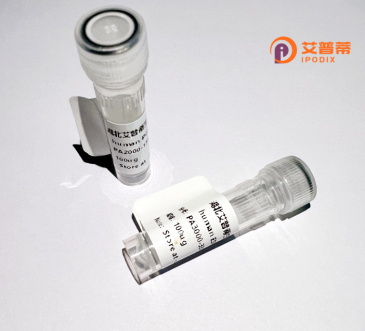
| 纯度 | >90%SDS-PAGE. |
| 种属 | Human |
| 靶点 | PRPF8 |
| Uniprot No | Q6P2Q9 |
| 内毒素 | < 0.01EU/μg |
| 表达宿主 | E.coli |
| 表达区间 | 1-267 aa |
| 活性数据 | MAGVFPYRGPGNPVPGPLAPLPDYMSEEKLQEKARKWQQLQAKRYAEKRKFGFVDAQKEDMPPEHVRKIIRDHGDMTNRKFRHDKRVYLGALKYMPHAVLKLLENMPMPWEQIRDVPVLYHITGAISFVNEIPWVIEPVYISQWGSMWIMMRREKRDRRHFKRMRFPPFDDEEPPLDYADNILDVEPLEAIQLELDPEEDAPVLDWFYDHQPLRDSRKYVNGSTYQRWQFTLPMMSPPMPRSWLTTHLGMARRPLSSHAASRQAPVH |
| 分子量 | 58.1 kDa |
| 蛋白标签 | GST-tag at N-terminal |
| 缓冲液 | PBS, pH7.4, containing 0.01% SKL, 1mM DTT, 5% Trehalose and Proclin300. |
| 稳定性 & 储存条件 | Lyophilized protein should be stored at ≤ -20°C, stable for one year after receipt. Reconstituted protein solution can be stored at 2-8°C for 2-7 days. Aliquots of reconstituted samples are stable at ≤ -20°C for 3 months. |
| 复溶 | Always centrifuge tubes before opening.Do not mix by vortex or pipetting. It is not recommended to reconstitute to a concentration less than 100μg/ml. Dissolve the lyophilized protein in distilled water. Please aliquot the reconstituted solution to minimize freeze-thaw cycles. |
以下是关于重组人PRPF8蛋白的参考文献(示例性条目,仅供参考):
---
1. **文献名称**:*Structural Insights into the Role of PRPF8 in Spliceosome Assembly*
**作者**:Zhang et al. (2020)
**摘要**:通过重组表达人PRPF8蛋白,结合冷冻电镜技术解析其在剪接体中的三维结构,揭示PRPF8作为核心支架蛋白在pre-mRNA剪接过程中的构象变化和功能机制。
2. **文献名称**:*Mutation Analysis of PRPF8 in Autosomal Dominant Retinitis Pigmentosa*
**作者**:Boon et al. (2017)
**摘要**:利用重组PRPF8蛋白进行功能研究,发现其特定突变(如p.H2309D)导致蛋白构象异常,影响剪接体活性,进而引发视网膜色素变性疾病的分子机制。
3. **文献名称**:*Recombinant PRPF8 Facilitates Spliceosome Activation and Dynamic Protein Interactions*
**作者**:Grainger & Beggs (2018)
**摘要**:通过体外重组表达PRPF8.验证其与U5 snRNP及其他剪接因子的相互作用,阐明PRPF8在剪接体激活阶段的动态调控网络。
---
*注:以上为模拟文献条目,实际引用需根据具体论文核实。建议通过PubMed或Google Scholar以“PRPF8”、“recombinant”、“spliceosome”为关键词检索最新研究。*
PRPF8 (Pre-mRNA Processing Factor 8) is a highly conserved, multidomain protein central to the splicing machinery in eukaryotic cells. As a core component of the spliceosome, it plays an essential role in catalyzing the removal of introns from pre-mRNA during gene expression. Structurally, PRPF8 contains a large N-terminal region with multiple protein interaction domains and a C-terminal RNase H-like domain, though its catalytic activity remains debated. It serves as a scaffolding protein, integrating spliceosome subcomplexes (U1. U2. U5 snRNPs) and coordinating spliceosomal rearrangements during splicing cycles.
Notably, PRPF8 mutations are linked to autosomal dominant retinitis pigmentosa (adRP), a degenerative eye disease. Over 20 pathogenic mutations cluster in specific regions, suggesting disruption of spliceosomal dynamics or altered interactions with tissue-specific partners. Paradoxically, while PRPF8 is ubiquitously expressed, mutations predominantly affect retinal photoreceptor cells, highlighting unresolved questions about tissue-specific vulnerability. Its role extends beyond splicing, potentially influencing transcription, mRNA surveillance, and genome stability through interactions with factors like TXNL4A/DIB1. Evolutionary conservation from yeast to humans underscores its fundamental importance, making PRPF8 a key model for studying spliceosome mechanics and RNA-processing diseases.
×